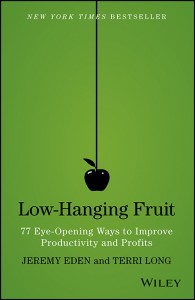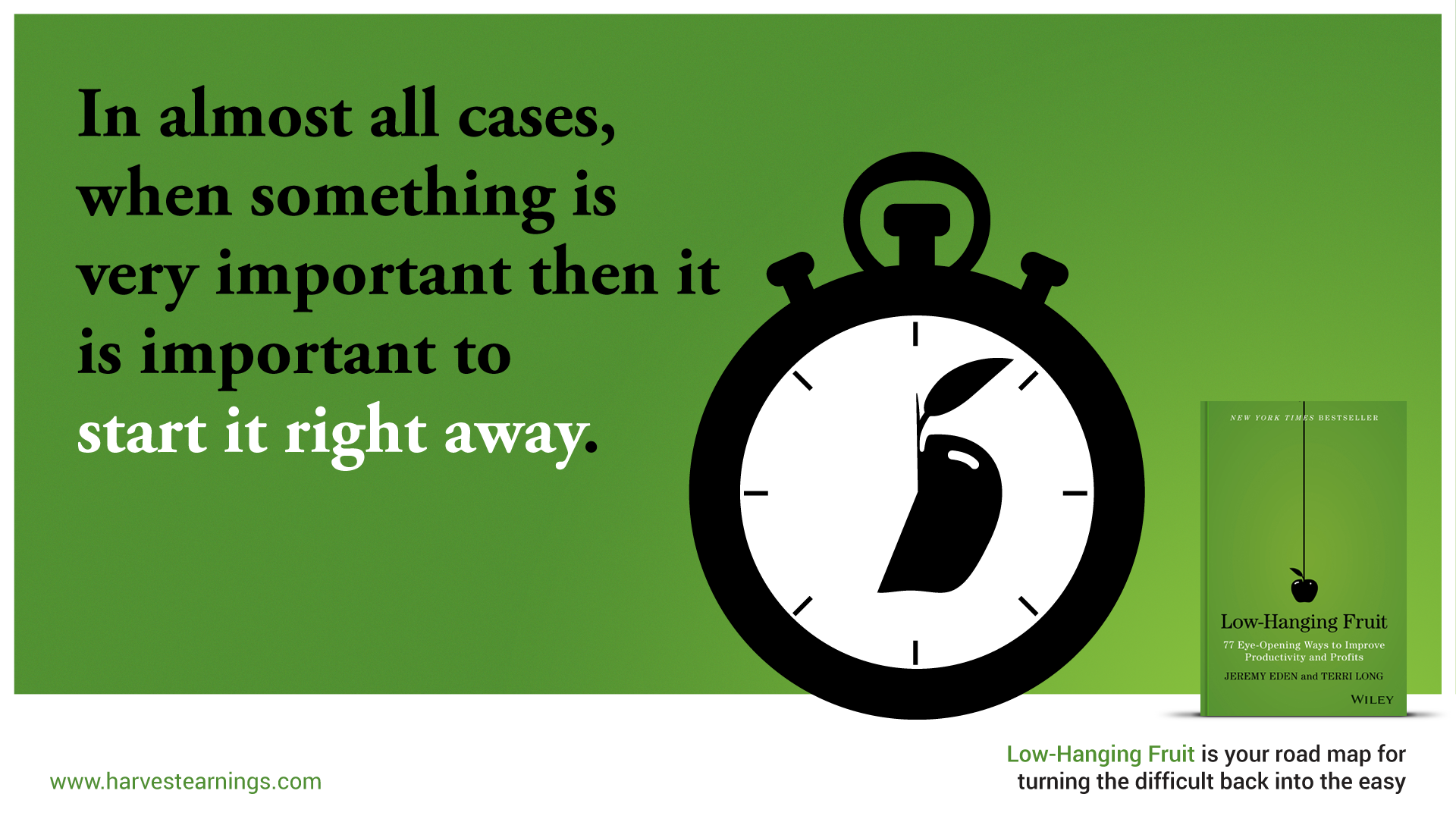Many leaders are looking for the “big” program that will change the game. They agonize over large scale change efforts, ways to reduce costs, and how to increase innovation within the firm.
What if the answer wasn’t identifying one large project but instead was small issues that employees already knew about? If the employees had the courage and the power to act on them, what would happen?
It’s the same in business as it is in life. The little things matter. Add up the small changes and the daily disciplines and you have mapped the road to success.
Jeremy Eden and Terri Long are the Co-CEOs of Harvest Earnings, an advisory services firm. They have helped companies like Heinz, PNC Financial, Standard Register and The Schwan Food Company, Energy East, Webster Financial, and Standard Register to reduce costs and increase revenues. I recently had the opportunity to talk with them about their new book, Low-Hanging Fruit: 77 Eye-Opening Ways to Improve Productivity and Profits.
This is one of the most practical and immediately actionable guides for business leaders that I have ever seen.
Embracing Change
You have listed numerous ways to make an organization more efficient, more productive, and more profitable. When you consult with an organization, do managers readily embrace your ideas or do they resist?
If we said to our clients’ employees, “Folks, here are 77 new behaviors you need to do now,” there would be mutiny! So instead we build in the most important behaviors into a process that we provide called Idea Harvest™. Most managers do readily embrace the process because they see that it is a way for them to get their ideas not only a hearing but a decision as well. By going through an Idea Harvest™ managers just naturally adopt our ideas without anyone having to learn or accept 77 ways of behaving. One of the most loved new behaviors is to use simple one-page summaries for most ideas and to stop creating big presentations. Since most decisions in an Idea Harvest are simple (“low-hanging fruit”), no lives need to be wasted on creating elaborate PowerPoints.
Another example is that an Idea Harvest uses many short deadlines. Deadlines focus everyone on important activities and give them permission to ignore unimportant ones that might otherwise waste their time. Some embrace this new behavior immediately because they see that it also means decisions will be made quickly. Others don’t see how they can meet the short deadlines until they see how efficiently they can work following some of the other rules … which is a perfect segue to the next question!
Know When Good Enough is Enough
I love the concept of “gold plating.” Would you explain it and give an example?
Gold plating, also known as “paving the cow paths” is an effort to make something better that is already good enough … and more specifically, spending time making that thing better does not grow profits. The most prevalent example is the one we describe in Chapter 77 “Mom Should Have Said, Don’t Always Do Your Best.” Managers spend an incredible amount of time perfecting PowerPoints, memos, and emails when “good enough” would have saved time that could be spent on truly important activities. Many bosses inadvertently encourage this behavior by pointing out meaningless typos or formatting issues in internal memos. We worked with one client where the employees laughed when we said the senior team would review a one-page summary of their ideas. They needed to hear directly from the CEO that he didn’t want a full blown presentation for every idea they were going to discuss! We worked with another where the word went out to reprint hundreds of pages of team reports in bigger font after the CEO made an off-hand comment that the type size was small – luckily the CEO caught wind of this and told everyone he preferred using his reading glasses to wasting time and money! One engineering department was designing equipment that would last 75 years even though with new technology that standard no longer made sense. “Gold plating” occurs in every large company and is seen as virtuous instead of the resource stealer that it is!
You talk about “embracing conflict” and that can require some serious culture change inside an organization. How do you change the culture to accept healthy conflict?
Managers bemoan how hard it is to change a culture, but we have seen it happen practically overnight. Think how quickly a culture can change when a company is bought and merged. The top dog has culture change within his or her power (but like Dorothy who didn’t know she only needed to click her heels three times, they often don’t know it.) Company executives who want their teams to embrace conflict must embrace it themselves. Is there a decision that has lingered because two factions can’t agree on the right course of action? Executives should adopt the mantra that “everyone is entitled to their own opinions but not their own facts” (courtesy of Senator Daniel Patrick Moynihan).
In practice, this means demanding facts before entertaining debate and discussion. By making sure that everyone agrees on the facts, many conflicts will be resolved. In one company, the business line wanted a 24-hour call center because they “knew” that good customers called at all hours while the call center “knew” that staying open overnight was not worth it. Together, they devised a simple data collection plan and determined that few good customers used the call center late at night. Again working together, they found a way to form a skeletal staff to take care of the customers with 3am needs. With common facts, a decade old conflict evaporated. With facts, conflicts also lose much of their political edge that can turn decisions into power struggles.
One additional simple change can make a huge difference: Get everyone involved in a decision in the room at the same time. No serial meetings with differing points of view that the boss is left to figure out. Ask the conflicting parties to present a single point of view on the issue and 95% of the time they will do it.
Making Meetings Effective
How do you make meetings more effective, less time consuming, and more impactful?
The average corporate meeting is such a deplorable waste of time that we dedicated six chapters to meetings in our book. Meetings are held with no clear agenda, without critical advance preparation, without well-defined outcomes and are attended by meeting tourists who come in case there are two minutes out of 60 that might matter to them.
Imagine how policy makers approach a meeting with the President of the United States. They don’t invite extraneous folks, with some straggling in late, just to give an update or generally discuss how to proceed. They first make sure that homework is done in preparation for the meeting; they carefully choose who should be in the meeting; they formulate very specific options and outcomes for the meeting; they use every minute focused on critical issues … and then they make sure that the follow-up is done. We grant that the President’s time is very important – but so is everyone else’s!
For example, if the goal is to decide on investing in a new machine, first have Finance, Engineering, Operations, and Procurement agree on the facts. Then determine who must participate in the decision and get their issues identified and addressed before the meeting. Then when everything is in place, have a short, well-prepared meeting to either make a decision or to discuss issues that truly require the group to hear together. And lastly, remember there is no requirement to book a 60-minute meeting for an issue that should take 22 minutes to discuss.
Unintentional Signals
Your book is full of ideas that I never expected when I first picked it up. For instance, how body language causes “unintentional squelch.” Would you share an example you observed of this squelch?
We’re glad we surprised you! Three “unintentional squelches” are the raised eyebrow, the grimace, and the drifting attention. We’ve been in countless meetings where the junior presenter has made a terrifically interesting point, and the boss raises an eyebrow as she or he thinks through various ramifications – but the junior presenter reads the eyebrow as disapproval. We’ve heard a boss asked why he grimaced over an idea say, “I don’t remember grimacing. Maybe that is when I realized that I’d forgotten to do something this morning – I do like the idea.” The drifting of attention is particularly common as meetings meander. To the person pitching an idea, the “attention drifter” seems dismissive. Unfortunately, many of the misinterpreted emotions don’t come to light until time and energy is wasted on them. Often, a good idea is dropped without cause.
You are not fans of benchmarking. Why not? What do you recommend instead?
Benchmarking gets in the way of making progress for one of two reasons. The first reason is that the unit doing the benchmarking proudly finds that they are above average for some metric. They declare victory and announce that there is little room for improvement. Unfortunately, they may just be in a category where everyone does pretty much the same thing while tremendous innovation awaits someone with more ambition.
The second reason is that the unit doing the benchmarking finds that it is below average. They purport that the supposed peer group isn’t really a fair comparison – and they are often right! So if a bank in a rural area compares its branch efficiency to a bank in urban areas, the rural bank will look like a poor performer even if they are, in fact, at the cutting edge for serving low volume regions while the urban bank is mediocre at serving large volume ones. Because companies vary so much, they often end up being forced to use so called peers that give misleading ideas about performance comparisons. Instead leaders should focus on their unique opportunities to improve – no matter what others are doing!
What tips do you have for motivating managers to be more productive?
Remove the de-motivators! Employees don’t enjoy living with frustrations, inefficiencies or providing poor customer service. They are forced to endure these things. Ask for and act on their ideas. Nothing de-motivates faster than not listening to employees’ frustrations and dismissing their ideas. Employees are looking for a way to find more meaning in their jobs and making a significant difference in improving their company counts toward that!
What are you reading?
We are both avid readers and enjoy many genres. We do read as many new business books as we can. But frankly, we wrote our book because we felt like so many popular business books disappoint because they do not offer practical advice. In terms of non-business books, we veer in very different directions. Right now, Terri is reading The Marcel Network by Fred Coleman. It is the story of a Syrian immigrant couple living in Nazi-occupied France who saved 527 children from the holocaust. It is a lesson in courage and ultimately uplifting. Jeremy, on the other hand, is a math nerd and is reading Our Mathematical Universe: My Quest for the Ultimate Nature of Reality by Max Tegmark. It is the ambitious attempt by an MIT Physics professor to show that the paradoxes of quantum physics and cosmology can be resolved by viewing the universe as an essentially mathematical object.
Low-Hanging Fruit: 77 Eye-Opening Ways to Improve Productivity and Profits



